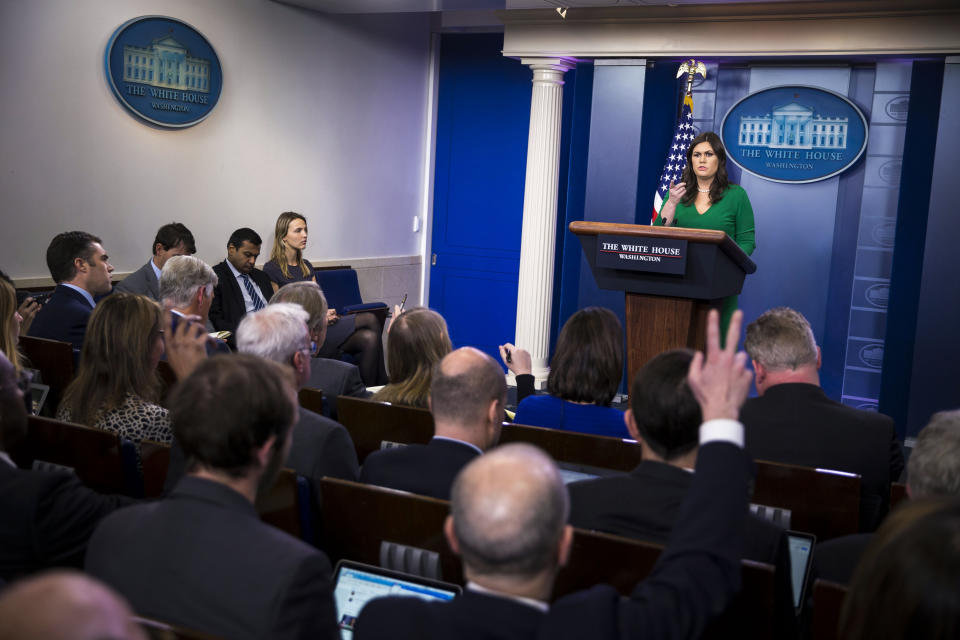How Sarah Sanders masterfully avoids answering a question
As White House press secretary, Sarah Sanders serves as a spokesperson for President Trump, taking tough questions from the press — and expertly avoiding them.
Her current challenge: defending the administration’s decision to employ former staff secretary Rob Porter despite domestic abuse allegations.
During Tuesday’s White House briefing, Sanders, 35, answered questions regarding the timeline surrounding Porter’s resignation, following claims, which Porter denies, from his two ex-wives that he was emotionally and physically abusive.

One large conflict centers on a muddled timeline: According to a detailed report by CNN, the FBI claims the White House learned of the allegations in 2017 and allowed Porter to continue working, despite an incomplete background check. But the White House maintains it learned of the scandal only on Feb. 7,the same day photos surfaced showing of one of Porter’s ex-wives, Colbie Holderness, with a black eye. The photos, which Holderness offered as proof of Porter’s abuse, went viral and Porter resigned.

At the podium Tuesday, Sanders explained that the White House was mired in an “ongoing process,” complex protocol, and red-tape bureaucracy that resulted in a delayed recommendation on whether or not to dismiss Porter.
She also declined to answer whether abuse allegations were included in Porter’s background check, saying: “I wouldn’t have access to that information. I wouldn’t know the answer to that.”
When asked whether other White House employees work without full security clearance, Sanders replied, “I can’t speak to [that] … and therefore can’t comment on the process.” And in response to whether the president was angry about not being fully briefed on Porter’s case, she said, “I haven’t asked him about that, specifically.”
Although it was clearly frustrating for reporters and people sitting at home, Sanders delivered an A-plus performance in avoidance, using insider PR techniques. “Sarah’s job isn’t to answer questions or facilitate an open dialogue between the president and press,” Victoria Voorhees, co-founder of Voorhees Segal Communications, tells Yahoo Lifestyle. “Her job is to deliver a singular point of view from the White House.”
Sanders achieves that with a technique called the “block and bridge,” allowing her to halt a question and pivot to her main point. “You’ll see this when she says, ‘I don’t know’ or ‘I haven’t asked the president,'” says Voorhees. “This is effective and smart, because it’s pretty hard to push someone after they’ve admitted they don’t have the answer. And from there, it’s easier to bridge back to your message.”

The mom of three also leans on the phrase “Let me get back to you on that,” in order to gracefully duck questions while respectfully acknowledging the asker.
Another move: Sanders’s tendency to use filler words, such as “look,” to grab control of the question and steer the conversation in a favorable way. “People who aren’t sure what to say often use filler words to buy time, break up the conversation, or slow down the other person,” says Voorhees.
Last, when faced with a tough query, Sanders is reactive and emotional. During a January White House briefing, when she was asked whether Donald Trump Jr. had ever committed treason, Sanders said, “I think that is a ridiculous accusation and one that I’m pretty sure we’ve addressed many times from here before.”
And on Tuesday, when asked how the White House could have better handled the Porter case, she replied, “Look, as I said yesterday, I think every day we come here we do the very best that we can, and every day we can do better than the day before. And we’re going to continue to strive for that. We’re humans, making us imperfect people. And so, every day I think we can learn from the day before, and we can strive to do better. And that’s our goal, certainly within our team, and we’re going to continue to try to do everything we can to help serve the American people to the best of our ability.”
Notes Voorhees, “When we train CEOs, we urge them to take their egos out of hard situations, because it can belittle serious topics and perpetuate conflict. Taking questions personally doesn’t set a respectful tone.”
Read more from Yahoo Lifestyle:
Support builds for teen who may be expelled for Planned Parenthood sticker on her laptop
Is Donald Trump going bald? Viral video exposes harsh reality of hair loss
Ivanka Trump will lead the Olympics’ closing ceremony, known for its ‘party-like atmosphere’
Follow us on Instagram, Facebook, and Twitter for nonstop inspiration delivered fresh to your feed, every day.

